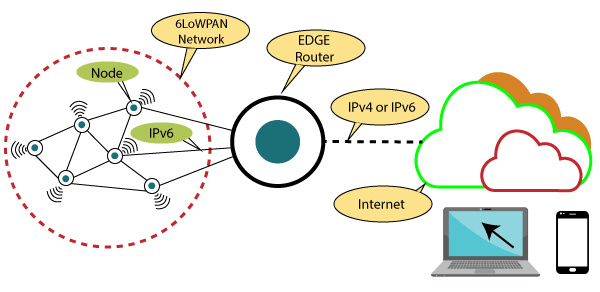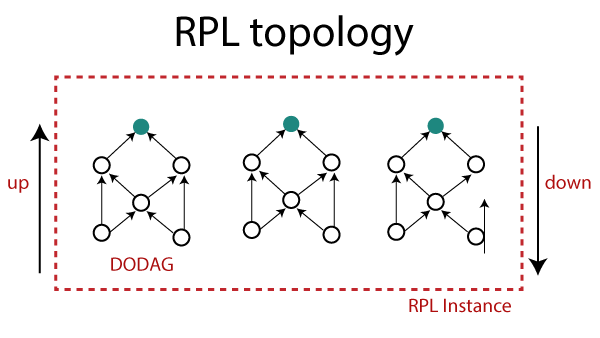Network layer Protocols
- Network layer Encapsulation Protocols
- Network Layer Routing Protocols
1. Network layer Encapsulation Protocols
a) 6LoWPAN
6LoWPAN stands for IPv6 Over Low-Power Wireless Personal Area Network. It is mostly used standard in this category. It effectively encapsulates long IPv6 headers in small IEEE802.15.4 packets that cannot exceed 128 bytes. The specification supports addresses of different lengths, low bandwidth, and different topologies, power consumption, low cost, scalable networks, mobility, unreliability, and extended downtime.

It provides header compression to reduce transmission costs, fragmentation to meet the maximum frame length of 128 bytes in IEEE802.15.4. It also supports multi-hop delivery.
6LoWPAN frames use four types of headers:
- No 6loWPAN header (00): In the case of the No 6loWPAN header, any frame that does not meet the 6loWPAN specification is ignored.
- Dispatch header (01): The dispatch header is used for multicast and IPv6 header compressions.
- Mesh header (10): The mesh headers are used to transmit data.
- Fragmentation header (11): The fragmentation headers divides the long IPv6 header so that it can contain fragments up to 128 bytes long.
b) 6TiSCH
The 6TiSCH is a working group at the IETF (Internet Engineering Task Force). The group develops the standards for IPv6.
2. Network Layer Routing Protocols
a) RPL
In 2012, the IETF launched a carrier remote Routing Protocol for Low Power (RPL) and Lossy Networks. RPL creates a Destination Oriented Directed Acyclic Graph (DODAG) that contains a single path from each leaf node to the root. The traffic of all nodes forwards to the root node. The root node decides to transfer a Destination Advertisement Object (DAO) from a node to communicate. It also handles the requests for DODAG Information Requests (DIS) from nodes wishing to join the network. RPL nodes can be stateless.

b) CORPL
CORPL or Cognitive RPL is an extension of RPL. It is designed for cognitive networks. It uses DODAG topology generation, but with two new modifications to RPL. CORPL uses an opportunistic transfer to return the packet by choosing the multiple senders. It coordinates the nodes to choose the next best hop to return the packet.
DODAG is built in the same way as RPL. In DODAG, each node retains a transfer set instead of just its parent and updates its neighbor with its modifications using DIO messages. Based on the updated information, each node dynamically updates its neighboring priorities to make up the set of forwarders.
c) CARP
CARP stands for Channel-Aware Routing Protocol. It is a distributed routing protocol used in Underwater Wireless Sensor Networks (UWSN). It has light-weight packets, so it is used with IoT. It performs two different functions: network initialization and data transfer.
CARP does not support the previously collected data. Therefore, it is not advantageous for IoT and other applications where the data changes frequently. The CARP update is done in E-CARP that exceeds the CARP limitation. E-CARP allows the receiving node to save previously received sensory data.